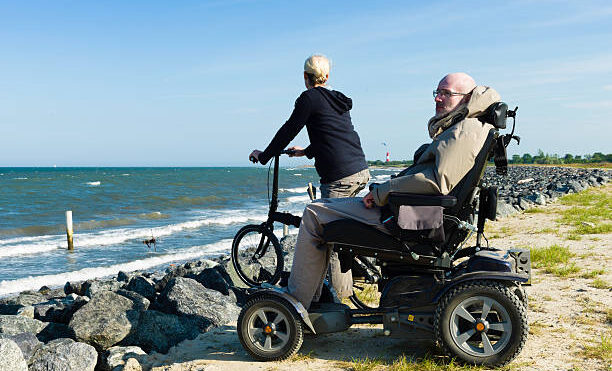Advantages Of Using Heavy Duty Wheelchairs
Do you find yourself feeling tight and uncomfortable in your wheelchair? Do you ever have the feeling that your car is laboring to get you from point A to point B? A heavy-duty wheelchair may be the answer to some of these issues. More significant people can enjoy all the advantages of a traditional wheelchair thanks to this unique product's design. Securing one's safety and comfort is equally crucial as a movement for the elderly.
Having the ability to move around is crucial for everyone who aspires to remain independent. A heavy-duty wheelchair allows riders to maintain their independence while moving around. Leaving the house, going shopping, or visiting friends or neighbors is no longer a concern for users who don't want to risk being uncomfortable or sacrificing their safety. More mobility is associated with increased social engagement. This is essential for sustaining excellent mental health and a high level of satisfaction with one's life.
An advantage of using a heavy-duty wheelchair is not only the improved mobility it provides. In addition, heavy users may experience greater comfort and security due to the technology. Heavy-duty wheelchairs are specifically built to handle more significant users and provide a more pleasant experience. They accomplish this by designing the chair in such a way that it accommodates the user's size as well as their weight, respectively. The user's freedom can be supported by these structural elements, which allow them to make their own decisions and carry out their daily activities without interference. However, if used in an incorrect setting, they can make it difficult to operate the chair properly. Furthermore, if the assessment and purchase processes are not reviewed in their entirety, it may prove to be a costly oversight.
In this article, we hope to provide you with information to help you choose the best sort of wheelchair. Even though heavy-duty wheelchairs have numerous advantages, this is not ideal for everyone. As you may be aware, a heavy-duty wheelchair may run into hundreds of dollars, so you must be sure that you meet the requirements.
This article is intended to assist you in making an informed selection that will provide you with the most incredible possible value for your money.
Heavy-Duty Wheelchair’s Design
A heavy-duty vinyl or upholstery material is used for the seats and backs of these chairs for additional support. Wheelchairs larger than standard wheelchairs provide more support for the user's sitting position, upper and lower back, and increased comfort. In most cases, the seat and backrest can be adjusted to accommodate an individual's center of gravity and to give sufficient support where it is required. People suffering from respiratory or cardiovascular disorders may also find it beneficial to tilt the backrest to help them breathe more easily.
With a weight capacity of 700 or even 1000 pounds, a heavy-duty wheelchair is built to last and used by people of all ages and sizes. You may be sure that your chair is powerful enough to transport you anywhere you need to go without the fear of destroying the chair or putting yourself in danger. Keeping more significant users in mind throughout the design process, the entire chair, including the leg and footrests, has been constructed with their comfort and safety as the number one priority at every stage of the process. While lightweight chairs are typically built of lighter materials such as aluminum, heavy-duty wheelchairs are usually constructed of steel, which provides more resilience to wear and tear.
People Best Fit for Heavy-Duty Wheelchairs?
For people over 100 pounds overweight and who have a body mass index (BMI) of more than 30, a heavy-duty wheelchair may be a valuable option for their mobility needs. Typically, the chairs' users suffer from a variety of ailments, including:
- Cardiovascular disease
- Osteoarthritis
- Cardiovascular and pulmonary disease
Another possibility is that people with extreme muscle weakness due to neurological or musculoskeletal disorders could use a wheelchair of this type. These are some examples of these conditions:
- Multiple Sclerosis
- Huntington's Disease
- Injuries to The Spinal Cord
- Muscular Dystrophy
Some overweight or have muscle weakness may face additional hazards when using a traditional wheelchair, which is why they should seek medical attention. A heavy-duty wheelchair is designed to overcome these difficulties. It may be ideal for heavier users who require both comfort and security and movement and freedom in their wheelchair.
Key Features of Heavy-Duty Power Wheelchairs
This type of chair is ideal for seniors and others with limited mobility and people who want to navigate inside and outside their homes with ease. This level of adaptability is challenging to come by in a single wheelchair design. These wheelchairs are a fantastic mode of transportation for exploring. You have the option of selecting a manual or heavy-duty electric wheelchair, as well as accessories that will match your specific requirements. Some of the most notable characteristics of these wheelchairs are as follows:
- Seat that can be folded
- Availability in several different sizes
- Power wheelchairs are simple to use with the help of a joystick
- The Extra-Wide Padded Seat
- Control panel that is state-of-the-art
- A more significant foot platform is available
- 4 to 6-wheel designs are available for maximum stability
- Some of them even feature flip-up armrests
- Available in a variety of colors
- The length of the lap belt can go up to 60" or more
By utilizing a variety of wheelchair attachments, a person can improve the overall performance and comfort of their power wheelchair. Examples of accessories with which we work include cushions for wheelchairs, wheelchair back cushions, cup holders with bags and covers, armrest accessories with covers (including batteries and chargers), cell phone holders with baskets for storing small items, cane or crutch holders, and so on.
Things to Consider Before Buying A Heavy-Duty Wheelchair
Wheelchairs can be pretty expensive, frequently costing thousands of dollars, and it is essential to give serious consideration before making a final purchase decision. Users should consider the seat width and weight capability of the chair. Other considerations should be the arm style; do you prefer a desk or full-length arms? Should the height be adjustable, or should it remain constant? Is it better to be cushioned or unpadded? Should the leg rest be immovable, swing away, elevating, cushioned, or unpadded, and what material should it be made of? You can also choose between a wheelchair that the user pushes and one that requires a pusher for transportation. Apart from these considerations, you need also take into account the following three factors:
The User
Standard wheelchair weight limitations are typically approximately 114-127kg hence you must be precisely weighed before using a wheelchair. Never approximate your weight when using a wheelchair.
Consider your strengths, such as whether or not you have the power or endurance to drive the heavy-duty wheelchair on your own or if you will need an attendant to do so.
Examine the jobs for which you already use or intend to use your heavy-duty wheelchair, as well as the things that are important to you. After that, a wheelchair that allows for high-quality involvement in these chores or activities should be obtained.
The Surrounding
If the heavy-duty wheelchair is used indoors, the home or work environment must be considered in the design process. As a result of their increased width and depth, these wheelchairs require more straight-line space while maneuvering through doorways and hallways to gain access to certain portions of a room or locations within a room. The heavier the wheelchair, the more attention must be paid to the floor surface. In addition, deep carpet creates more resistance, making it more difficult to self-propel and accompanying propel through.
The Wheelchair
Comfort is critical because it allows the wheelchair user to participate in creative pursuits and suggests that pressure regions are likely to be managed. That isn't always the case, as poor posture may be ingrained in the body, making correct posture painful until the body becomes accustomed to the new position. It is essential to utilize a sufficient heavy-duty wheelchair cushion with proper pressure relief and ensure that the cushion is the correct size for the wheelchair. No significant gaps should exist between the frame of the wheelchair and the cushion unless otherwise specified.
It is important to remember that the heavy-duty wheelchair and the rider's combined weight are essential. It is necessary to consider the long-term viability of this combined weight for either independent or attendant propulsion. A variety of lightweight, heavy-duty wheelchair alternatives are available on the market that may be an excellent all-around answer.
Consider the type of wheels that have been chosen. Because solid or PU tires, constructed of rubber or plastic, are typically believed to be the most suited because they cannot be punctured or deflated. They are often the most popular choice. The most significant disadvantage of a solid tire is that it is significantly heavier, making it much more difficult to move and transport the tire. This may or may not be a problem, but the user must consider all factors to ensure that it fulfills their specific requirements.
Advantages of a Heavy-Duty Wheelchair
Since most heavy-duty wheelchairs are not movable, their frames are constructed of sturdy, heavy-duty steel tubing, with steel bars on the heavier variants. These wheelchairs also have strengthened welds, and the larger and more powerful motors provide substantially more torque, helping heavy patients to go over practically any surface with ease.
Other characteristics that distinguish heavy-duty wheelchairs from their lighter counterparts are as follows:
Larger Batteries
Because this type of wheelchair is intended to be used frequently and, at times, to power numerous parts of the wheelchair simultaneously, it is equipped with heavy-duty batteries. Because of the increased capacity of these batteries, users can anticipate traveling distances ranging from 11 to 32 miles per charge, depending on their needs.
When it comes to heavy-duty wheelchairs, seamless acceleration and max speed of 3.5 mph to 5 mph can be achieved regardless of the user's weight.
Wider Seats
There are various sizes available, ranging from around 20" in height to 28" in width and between 18" and 28" in depth. Seat frames are available in multiple colors. Because of the design of these heavy-duty wheelchairs, you can be confident that the seat structure will be built to withstand the rigors of individuals weighing 500 lbs. or more. Some models even include a reclining or raising seat to provide the most comfortable seating possible.
Turning Radius
If you've never heard of the term before, it simply refers to the amount of space (measured in inches) that a wheelchair takes to turn in a perfect circle while being pushed or pulled. As a result, the narrower the turning radius, the more excellent maneuverability your heavy-duty wheelchair will have.
For a wheelchair with a high weight capacity to turn, several things must be considered. For example, in addition to frame length and seat width, we must also consider how far the footrests reach over the front and rear of the chassis, depending on the model. The position and size of the seat, as well as the type of footrest, can all have an impact on the turning radius of a large motorized wheelchair.
High Weight Capacities
Folks refer to these wheelchairs as "high weight capacity power wheelchairs" for a perfect reason while the smaller and slightly lighter variants are capable of withstanding a weight of 300 lbs., the larger and more powerful ones are capable of withstanding weights of more than 600 lbs.
Heavy-duty power wheelchairs won't have to worry about hampered stability or performance when they're ridden over high surfaces or uneven terrain.
Good for Both Indoors and Outdoors
Heavy-duty power wheelchairs are commonly used indoors and outdoors, depending on the situation. If you intend to use yours primarily inside, you should look for a model with a turning radius somewhere between 22" and 35" to maximize its efficiency.
These wheelchairs are also the most suitable for use outdoors, as the heavyweight, more powerful models are capable of navigating incline surfaces ranging from 7.5° to 10° with ease, as well as navigating all types of outdoor land – however, their turning radius is significantly greater, ranging from 45-55".
Bottom Line
A heavy-duty wheelchair may alleviate some of these issues for some people. Thanks to this innovative product's design, all the advantages of a traditional wheelchair can be enjoyed by larger people. Securing one's safety and comfort is equally as crucial as a movement for the elderly. Having the ability to move around is vital for everyone who aspires to remain independent. A bariatric wheelchair allows users to maintain their independence while moving around. Leave their houses, go shopping, or visit friends or neighbors without the fear of being unpleasant or jeopardizing their safety. More mobility is associated with increased social engagement. This is essential for sustaining excellent mental health and a high level of satisfaction with one's life.
As with any functional, mobility, or healthcare equipment, it is critical to get counsel from a qualified healthcare expert before using the equipment. As a result of their assistance and evaluation of the advice above, you can be confident that the heavy-duty wheelchair will meet your demands.






I appreciate you pointing out that people refer to these wheelchairs as “high weight capacity power wheelchairs” for exactly the right reasons and that the smaller, slightly lighter models can support up to 300 lbs. My grandfather is unable to walk long distances. I’ll purchase for him a retail motorized wheelchair with a large weight capacity.